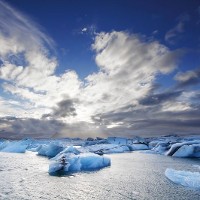Reducing black carbon deposition in the Arctic region
Atmospheric black carbon or soot affects climate via a number of pathways. Black carbon deposits on snow and ice darken the surface, which causes it to absorb more solar radiation and accelerates melting. Black carbon is also a component of particulate matter, which has adverse human health effects. Unlike long-lived CO2, black carbon, one of the biggest contributors to global warming, remains for just days to weeks in the atmosphere. Reduction of pollutants like black carbon represents a tangible policy option for near-term climate change mitigation.
White Paper
IIASA coauthored a draft White Paper “Current Policies, Emission Trends and Mitigation Options for Black Carbon in the Arctic Region” for the Arctic Council’s ministerial
meeting in 2009. Subsequently the Arctic Council established a Task Force to examine more deeply the role and mitigation potential of SLCFs in the Arctic. Its key message was that simultaneously and immediately reducing black carbon and methane emissions can help
slow the pace of Arctic warming over the next few decades.
Black carbon origins
The White Paper showed that while some black carbon is produced in the Arctic itself, for example, by shipping, most is fall-out from the eight Arctic Council nations and the near-Arctic regions north of latitude 40, which includes much of the EU, Russia, Ukraine, China (north of
Beijing), Canada, and part of the USA. Burning diesel fuel, agricultural burning, wildfires, and residential combustion of solid fuels account for most black carbon that reaches the Arctic.
Impacts
- Almost five years of research by IIASA scientists into Arctic air pollution led to the formation in 2014 of the before Arctic Futures Initiative (AFI) which will take a holistic, systems based perspective of the whole Arctic and near-Arctic region. • Work by IIASA in 2013, in collaboration with the Arctic Council and the Arctic Monitoring and Assessment Program collected new data on seasonal patterns and temporal variations of black carbon deposition, focusing on Finland. The research showed that the contribution of residential emissions to black carbon pollution in the Arctic was greater than previously estimated and that its main source was wood burning.
- IIASA is applying the GAINS model to project the effect of current and forthcoming air quality policies and legislation on particulate matter emissions on warming in the Arctic. The research, supported by the EU, will identify where additional mitigation measures can make a difference and at what cost.
- In 2012 IIASA included a new GAINS emissions set in the new global scenarios which identifies all key aerosol and methane emission sources and mitigation opportunities in the Arctic. The new scenarios explicitly feature the adverse effects of kerosene wick lamps, used in millions of developing-country households, and diesel electricity generators. They also update global estimates for solvent use and oil and gas production and distribution.
- The Climate and Clean Air Coalition (CCAC) to Reduce Short Lived Climate Pollutants was established in 2012 on the basis of research by IIASA using GAINS and by NASA’s Goddard Institute for Space Studies. CCAC is a voluntary partnership of nearly one hundred country and nonstate partners. The IIASA Air Quality and Greenhouse Gases program director serves on its Scientific Advisory Panel.

Reducing Black Carbon Deposition in the Arctic Region (PDF)


